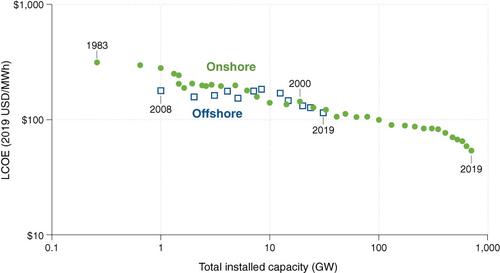当前位置:
X-MOL 学术
›
WIREs Energy Environ.
›
论文详情
Our official English website, www.x-mol.net, welcomes your feedback! (Note: you will need to create a separate account there.)
Wind power costs driven by innovation and experience with further reductions on the horizon
Wiley Interdisciplinary Reviews: Energy and Environment ( IF 6.1 ) Pub Date : 2021-03-31 , DOI: 10.1002/wene.398 Philipp Beiter 1 , Aubryn Cooperman 1 , Eric Lantz 1 , Tyler Stehly 1 , Matt Shields 1 , Ryan Wiser 2 , Thomas Telsnig 3 , Lena Kitzing 4 , Volker Berkhout 5 , Yuka Kikuchi 6
Wiley Interdisciplinary Reviews: Energy and Environment ( IF 6.1 ) Pub Date : 2021-03-31 , DOI: 10.1002/wene.398 Philipp Beiter 1 , Aubryn Cooperman 1 , Eric Lantz 1 , Tyler Stehly 1 , Matt Shields 1 , Ryan Wiser 2 , Thomas Telsnig 3 , Lena Kitzing 4 , Volker Berkhout 5 , Yuka Kikuchi 6
Affiliation

|
The costs of wind power have declined to levels on par with or below those of conventional sources in many parts of the world. Wind power has become one of the fastest-growing sources of new electricity generation. We take stock of wind power cost evolution over the past 20 years, review methodologies commonly used for cost assessment, discuss the potential for continued cost reduction, and identify anticipated cost and value drivers. Our scope includes both onshore and offshore wind technologies. We draw from a vast body of literature on these topics to highlight key trends, approaches, and limitations. Furthermore, we discuss strategies for wind power assets to enhance their marginal economic value to the broader power system and consumers. We identify a myriad of factors that are expected to influence the future cost and value of wind power, including siting, project scale, turbine size, operational synergies, commodity prices, advancements in turbine technologies, enhanced management of the wind resource, and novel control technologies that provide value for the electricity grid. Because the common methods for forecasting future costs each have their own strengths and weaknesses, we find the best insights are elicited from a combination of methods. Overall, researchers and analysts anticipate further sizable cost reductions for onshore and offshore wind. Midrange forecasts for levelized cost of energy in 2050 are generally between $20 and $30/MWh for onshore wind and $40 and $60/MWh for offshore wind, a reduction to approximately half of today's levels. Optimistic forecasts anticipate these levels as early as 2030.
中文翻译:

由创新和经验驱动的风电成本即将进一步降低
在世界许多地方,风电的成本已经下降到与传统能源相当或更低的水平。风电已成为增长最快的新发电来源之一。我们评估了过去 20 年风电成本的演变,审查了成本评估常用的方法,讨论了持续降低成本的潜力,并确定了预期的成本和价值驱动因素。我们的范围包括陆上和海上风电技术。我们从关于这些主题的大量文献中汲取灵感,以突出关键趋势、方法和局限性。此外,我们讨论了风电资产的战略,以提高其对更广泛的电力系统和消费者的边际经济价值。我们确定了许多预计会影响风电未来成本和价值的因素,包括选址、项目规模、涡轮机规模、运营协同效应、商品价格、涡轮机技术的进步、风力资源的加强管理以及为电网提供价值的新型控制技术。因为预测未来成本的常用方法各有优缺点,所以我们发现最好的见解是从方法的组合中得出的。总体而言,研究人员和分析师预计陆上和海上风电的成本将进一步大幅降低。对 2050 年平准化能源成本的中等预测通常在陆上风电 20 至 30 美元/MWh 之间,海上风电 40 至 60 美元/MWh 之间,降低到目前水平的大约一半。乐观的预测预计这些水平最早会在 2030 年出现。商品价格、涡轮机技术的进步、风力资源的加强管理以及为电网提供价值的新型控制技术。因为预测未来成本的常用方法各有优缺点,所以我们发现最好的见解是从方法的组合中得出的。总体而言,研究人员和分析师预计陆上和海上风电的成本将进一步大幅降低。对 2050 年平准化能源成本的中等预测通常在陆上风电 20 至 30 美元/MWh 之间,海上风电 40 至 60 美元/MWh 之间,降低到目前水平的大约一半。乐观的预测预计这些水平最早会在 2030 年出现。商品价格、涡轮机技术的进步、风力资源的加强管理以及为电网提供价值的新型控制技术。因为预测未来成本的常用方法各有优缺点,所以我们发现最好的见解是从方法的组合中得出的。总体而言,研究人员和分析师预计陆上和海上风电的成本将进一步大幅降低。对 2050 年平准化能源成本的中等预测通常在陆上风电 20 至 30 美元/MWh 之间,海上风电 40 至 60 美元/MWh 之间,降低到目前水平的大约一半。乐观的预测预计这些水平最早会在 2030 年出现。以及为电网提供价值的新型控制技术。因为预测未来成本的常用方法各有优缺点,所以我们发现最好的见解是从方法的组合中得出的。总体而言,研究人员和分析师预计陆上和海上风电的成本将进一步大幅降低。对 2050 年平准化能源成本的中等预测通常在陆上风电 20 至 30 美元/MWh 之间,海上风电 40 至 60 美元/MWh 之间,降低到目前水平的大约一半。乐观的预测预计这些水平最早会在 2030 年出现。以及为电网提供价值的新型控制技术。因为预测未来成本的常用方法各有优缺点,所以我们发现最好的见解是从方法的组合中得出的。总体而言,研究人员和分析师预计陆上和海上风电的成本将进一步大幅降低。对 2050 年平准化能源成本的中等预测通常在陆上风电 20 至 30 美元/MWh 之间,海上风电 40 至 60 美元/MWh 之间,降低到目前水平的大约一半。乐观的预测预计这些水平最早会在 2030 年出现。研究人员和分析师预计陆上和海上风电的成本将进一步大幅降低。对 2050 年平准化能源成本的中等预测通常在陆上风电 20 至 30 美元/MWh 之间,海上风电 40 至 60 美元/MWh 之间,降低到目前水平的大约一半。乐观的预测预计这些水平最早会在 2030 年出现。研究人员和分析师预计陆上和海上风电的成本将进一步大幅降低。对 2050 年平准化能源成本的中等预测通常在陆上风电 20 至 30 美元/MWh 之间,海上风电 40 至 60 美元/MWh 之间,降低到目前水平的大约一半。乐观的预测预计这些水平最早会在 2030 年出现。
更新日期:2021-03-31
中文翻译:

由创新和经验驱动的风电成本即将进一步降低
在世界许多地方,风电的成本已经下降到与传统能源相当或更低的水平。风电已成为增长最快的新发电来源之一。我们评估了过去 20 年风电成本的演变,审查了成本评估常用的方法,讨论了持续降低成本的潜力,并确定了预期的成本和价值驱动因素。我们的范围包括陆上和海上风电技术。我们从关于这些主题的大量文献中汲取灵感,以突出关键趋势、方法和局限性。此外,我们讨论了风电资产的战略,以提高其对更广泛的电力系统和消费者的边际经济价值。我们确定了许多预计会影响风电未来成本和价值的因素,包括选址、项目规模、涡轮机规模、运营协同效应、商品价格、涡轮机技术的进步、风力资源的加强管理以及为电网提供价值的新型控制技术。因为预测未来成本的常用方法各有优缺点,所以我们发现最好的见解是从方法的组合中得出的。总体而言,研究人员和分析师预计陆上和海上风电的成本将进一步大幅降低。对 2050 年平准化能源成本的中等预测通常在陆上风电 20 至 30 美元/MWh 之间,海上风电 40 至 60 美元/MWh 之间,降低到目前水平的大约一半。乐观的预测预计这些水平最早会在 2030 年出现。商品价格、涡轮机技术的进步、风力资源的加强管理以及为电网提供价值的新型控制技术。因为预测未来成本的常用方法各有优缺点,所以我们发现最好的见解是从方法的组合中得出的。总体而言,研究人员和分析师预计陆上和海上风电的成本将进一步大幅降低。对 2050 年平准化能源成本的中等预测通常在陆上风电 20 至 30 美元/MWh 之间,海上风电 40 至 60 美元/MWh 之间,降低到目前水平的大约一半。乐观的预测预计这些水平最早会在 2030 年出现。商品价格、涡轮机技术的进步、风力资源的加强管理以及为电网提供价值的新型控制技术。因为预测未来成本的常用方法各有优缺点,所以我们发现最好的见解是从方法的组合中得出的。总体而言,研究人员和分析师预计陆上和海上风电的成本将进一步大幅降低。对 2050 年平准化能源成本的中等预测通常在陆上风电 20 至 30 美元/MWh 之间,海上风电 40 至 60 美元/MWh 之间,降低到目前水平的大约一半。乐观的预测预计这些水平最早会在 2030 年出现。以及为电网提供价值的新型控制技术。因为预测未来成本的常用方法各有优缺点,所以我们发现最好的见解是从方法的组合中得出的。总体而言,研究人员和分析师预计陆上和海上风电的成本将进一步大幅降低。对 2050 年平准化能源成本的中等预测通常在陆上风电 20 至 30 美元/MWh 之间,海上风电 40 至 60 美元/MWh 之间,降低到目前水平的大约一半。乐观的预测预计这些水平最早会在 2030 年出现。以及为电网提供价值的新型控制技术。因为预测未来成本的常用方法各有优缺点,所以我们发现最好的见解是从方法的组合中得出的。总体而言,研究人员和分析师预计陆上和海上风电的成本将进一步大幅降低。对 2050 年平准化能源成本的中等预测通常在陆上风电 20 至 30 美元/MWh 之间,海上风电 40 至 60 美元/MWh 之间,降低到目前水平的大约一半。乐观的预测预计这些水平最早会在 2030 年出现。研究人员和分析师预计陆上和海上风电的成本将进一步大幅降低。对 2050 年平准化能源成本的中等预测通常在陆上风电 20 至 30 美元/MWh 之间,海上风电 40 至 60 美元/MWh 之间,降低到目前水平的大约一半。乐观的预测预计这些水平最早会在 2030 年出现。研究人员和分析师预计陆上和海上风电的成本将进一步大幅降低。对 2050 年平准化能源成本的中等预测通常在陆上风电 20 至 30 美元/MWh 之间,海上风电 40 至 60 美元/MWh 之间,降低到目前水平的大约一半。乐观的预测预计这些水平最早会在 2030 年出现。


























 京公网安备 11010802027423号
京公网安备 11010802027423号